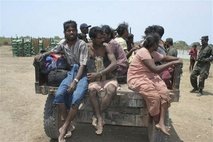 A top U.N. official headed to Sri Lanka on Friday on an urgent mission to safeguard civilians trapped by fighting as thousands of desperate war refugees escaped across the front lines into government territory.
A top U.N. official headed to Sri Lanka on Friday on an urgent mission to safeguard civilians trapped by fighting as thousands of desperate war refugees escaped across the front lines into government territory.
Government officials say they have cornered the Tamil Tiger rebels in a tiny coastal strip and stand poised to end this island nation’s quarter-century civil war.
However, international concern has grown for tens of thousands of civilians under threat from the heavy artillery bombardments shaking the war zone, and the Red Cross warned of "an unimaginable humanitarian catastrophe" for the hundreds of wounded trapped without treatment.
Nearly 4,000 civilians waded across a lagoon overnight and broke out of the war zone, while another thousand waited to flee, military spokesman Brig. Udaya Nanayakkara said Friday. The rebels fired on those leaving, killing four and wounding 14 others, he said.
About 200,000 civilians have escaped the war zone in recent months and are being held in overwhelmed displacement camps.
The rebels have denied accusations they were holding the civilians as human shields and shooting at those trying to flee. Reports of the fighting are difficult to verify because the government has barred journalists and most aid workers from the conflict zone.
Hoping to end the bloodshed, U.N. Secretary-General Ban Ki-moon sent his chief of staff, Vijay Nambiar, to Sri Lanka for a second time to try to bring the conflict to a peaceful conclusion.
Nambiar is expected to meet with top government officials after he arrives Saturday and push for ways "to secure the safety of the 50,000 to 100,000 civilians remaining inside the combat zone," U.N. spokesman Gordon Weiss said.
Meanwhile, U.S. Secretary of State Hillary Rodham Clinton said that in light of the ongoing war, the United States had raised questions about Sri Lanka’s application for a $1.9 billion IMF loan that the government desperately needs.
"We think that it is not an appropriate time to consider that until there is a resolution," she said in Washington.
The U.N. says 7,000 civilians were killed and 16,700 wounded in the fighting from Jan. 20 until May 7, according to a U.N. document given to The Associated Press by a senior diplomat. Since then, doctors in the war zone say more than 1,000 civilians were killed in a week of heavy shelling that rights groups and foreign governments have blamed on Sri Lankan forces. Sri Lanka denies firing heavy weapons into the war zone.
On Thursday, doctors and health aides abandoned the only hospital in the war zone because of the intense shelling, according to a health official in the war zone who spoke on condition of anonymity because he was not authorized to talk to the media.
About 400 badly wounded patients remained inside in desperate need of treatment, along with more than 100 bodies waiting to be buried, the official said. The medical staff huddled in a nearby bunker and tried to ignore the cries of patients begging for help, he said.
A Red Cross ferry attempting to deliver desperately needed food aid and evacuate the wounded had to turn back for the third day Thursday because of the violence.
"Our staff are witnessing an unimaginable humanitarian catastrophe," Pierre Krahenbuhl, the International Committee of the Red Cross’ director of operations, said of the patients in the hospital.
The Red Cross said the trapped civilians inside the war zone were taking cover in bunkers they had dug in the ground and were finding it even more difficult to get scarce drinking water and food.
(For updates you can share with your friends, follow TNN on Facebook and Twitter )
